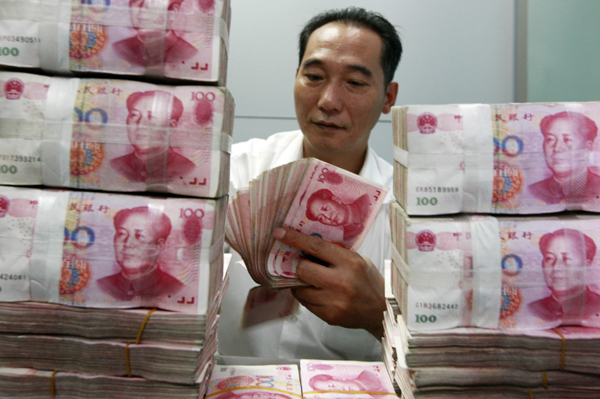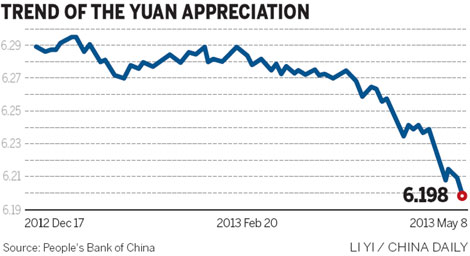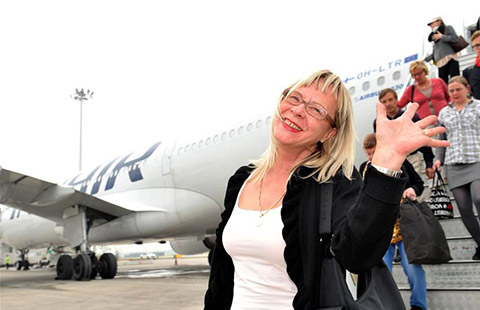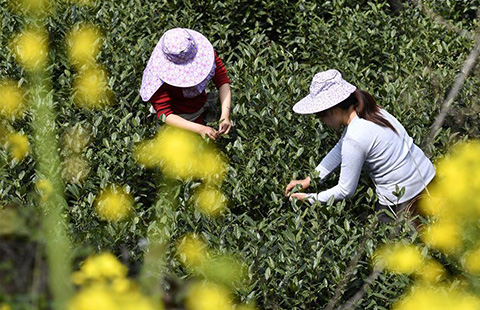Yuan reference rate hits high
|
 A worker counts and stacks banknotes at an Industrial and Commercial Bank of China branch in Huaibei, Anhui province. The yuan is allowed to trade within 1 percent in each direction around the daily reference rate set by the central bank. [Photo/China Daily]
|
Daily fixing of currency rises 1.41% against dollar since start of this year
The People's Bank of China on Wednesday set the daily reference rate of the yuan against the dollar at 6.1980, the highest in 19 years since China unified the official and market exchange rates at the end of 1993.

Later, the yuan closed at 6.1410 against the dollar in Shanghai, according to the China Foreign Exchange Trade System. It touched 6.1396 earlier, the strongest level since the end of 1993.
The daily fixing of the yuan rose 1.41 percent since the beginning of the year against the dollar, as indicators show that capital flows into the world's second-largest economy accelerated in recent months.
The yuan is allowed to trade within 1 percent in each direction around the daily reference rate.
"Appreciation expectations and onshore demand for the currency still dominate the market as capital inflows continue, and the authorities are working to make the pricing of the yuan more flexible and market-oriented," said Guo Tianyong, a professor at the Central University of Finance and Economics in Beijing.
The State Council, China's cabinet, said this week it will draft an operational plan to achieve full convertibility of the yuan and establish a comprehensive system for individuals' outbound investments.
Analysts have forecast continuous appreciation pressure on the yuan as major economies announced a new round of monetary easing. On Monday, the central bank of Australia said it will cut interest rates by 25 basis points, following the steps of the European Central Bank and the Indian central bank.
China has seen four straight months of net foreign exchange purchases among the central bank and commercial lenders, which suggests continuous capital inflows.
The central bank data showed that banks brought in nearly 236.3 billion yuan ($38.25 billion) worth of foreign exchange in March on a net basis, boosting the total yuan holdings for purchasing foreign currency to nearly 27.1 trillion yuan.
Apart from international "hot money" inflows, the rising willingness of Chinese companies, especially property developers, to sell dollar-denominated bonds in overseas markets also contributed to increasing cross-border money inflows, said Ding Zhijie, dean of the School of Banking and Finance at the University of International Business and Economics in Beijing.
Expectations of the yuan's appreciation have also strengthened as China's band-widening discussions have been rekindled following recent comments from PBOC officials indicating that the yuan trading band will be further widened "in the near future".
And the tightening of foreign exchange rules this week could well lay the groundwork for a band-widening move later this year, said Australia and New Zealand Banking Group Ltd in a report.
On Sunday, the State Administration of Foreign Exchange rolled out new rules to regulate the banks' dollar net open positions, or NOP, linking their onshore foreign exchange loan-to-deposit ratios with the regulated NOP floor.
It also called for stricter scrutiny of foreign exchange transactions by exporters and importers.
The new SAFE rules do not alter the fundamental reasons behind yuan appreciation, but rather eliminate the speculative elements seeking to profit from the appreciation, said Li Wei, a senior economist at Standard Chartered Bank.
"China's modest external surplus, favorable interest-rate differentials and the role of the yuan appreciation in internationalization continue to favor gradual appreciation medium-term," he said.
Ding said that it's still possible that the yuan will go down for a while after this phase of appreciation, as the negative impact of Japanese yen's depreciation on East Asian countries' trade balance will gradually loom large, leading to currency depreciation among these countries.
















